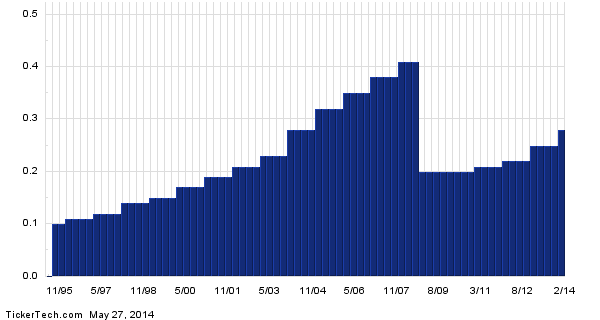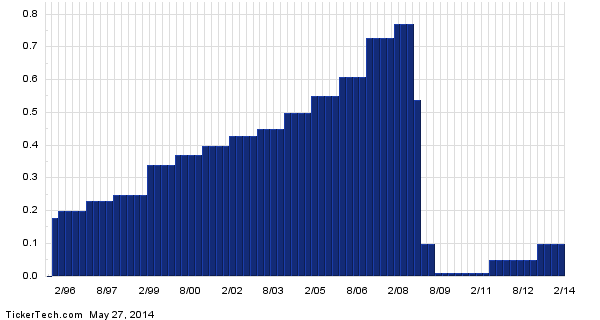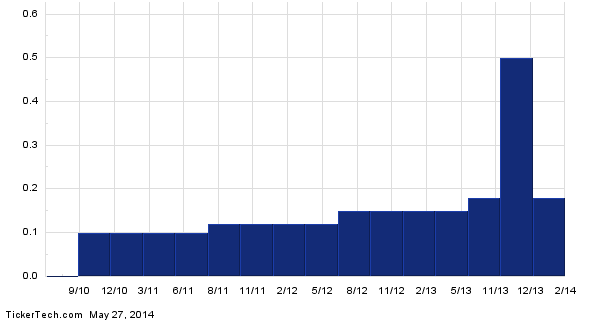Company History and Business
In 2010 Brazil's HRT Participacoes em Petroleo S.A. (HRTPY.PK) raised $1.5 billion in an IPO to fund a highly touted and highly expensive oil & gas exploration campaign in both the Amazon and offshore Namibia. Management was very promotional and overpromised and underdelivered. The three exploration wells in Namibia were all failures and the Conclusion of Solimoes Gas Monetization Study leads the market (myself included) to conclude that there is little or no present value in the discoveries in the Solimoes basin. The stock has lost 85% in just the last year, and over 97% in the last three years. Early investors like Southeastern Asset Management have lost most of their money and have either given up or believe the market cap has become too small and insignificant to warrant further examination.
I too have lost most of my original investment as the high risk/high reward investment thesis of my past GuruFocus article has failed to materialize. However, according to the late John Templeton, stocks that have recently dropped by 85% or more are worth examination. For those of you who can look at this stock with a fresh perspective, HRT's recent acquisition of their 60% interest in the Polvo field from BP for $135 million now offers shareholders limited downside with significant upside.
Summary
HRT has no debt and $139 million in cash. Market capitalization is $99 million.
HRT trades at $17000 per barrel of flowing oil per day
Present value of proved developed producing reserves is $94.6 million
Present value of total proved reserves is $294 million
Present value of proved+probable reserves is $514 million
HRT has 'free' exposure to convexity with the Meerkat-1 prospect in Namibia.
Financial Strength
HRT has no debt and a market cap of $99 million.
The present value of just the proved developed producing reserves is $94.6 million.
The present value of all of the proved reserves is $294 million and the proved+probable reserves is $514 million (more about valuation of reserves in the valuation section).
Pro forma cash, equivalents and marketable securities is about $139 million. However, the following pending arbitration proceedings may reduce the cash by up to $69 million:
1) Tuscany Perfuracoes Brasil Ltda. and Tuscany Rig Leasing SA. (collectively, "Tuscany") have commenced an arbitration proceeding against HRT O&G pursuant to which Tuscany is claiming an amount of $USD 39,644,601.99 to HRT O&G. In response to such claim, HRT O&G filed a counterclaim claiming an amount of $USD 18,943,655.28. The company is currently waiting for the procedural order to present closing arguments.
2) $USD 28.6 MM arbitration proceeding with Geoquasar
This arbitration was filed February 2014 and probably will take one or two years before a ruling is made.
If HRT completely lost both arbitration cases tomorrow, the pro forma cash position drops from $139 million to a respectable $70 million. HRT's proven reserves are bankable assets so clearly this unlevered company has a very strong financial position.
Valuation
As a value investor I believe that the intrinsic value is the future earnings discounted to the present. One of the nice things about investing in the oil and gas industry is that third party reserves auditors estimate the present value of the reserves for us. The DeGoyler and MacNoughton's report of the reserves of the Polvo field dated 31-Dec-2013 states that the net reserves and their present value, discounted at 10%, are as follows:
Proved developed producing (PDP) reserves = 4.8 million barrels
Total proved (1P) reserves = 9.0 million barrels
Proved+Probable (2P) reserves = 15.6 million barrels
Pretax present value of proved developed producing reserves, PDP PV10% = $94.6MM
Pretax present value of proved reserves, 1P PV10% = $294MM
Pretax present value of Proved+Probable reserves, 2P PV10% = $514MM

While reserve auditors have a good track record of estimating the quantity of reserves, they rely on the company to provide estimates of the operating expenses, capital costs, and the timing of those costs to estimate the present value of the reserves. Delays and cost overruns happen and companies are prone to make optimistic assumptions, especially when preparing estimates to present to others. However, in the case of HRT the PV10% values should be fairly accurate estimates for the following reasons (assuming the flat $99.56 per barrel is an accurate assumption):
1) All the capital costs have been laid out for the proved developed producing reserves and there is a seven year operating history to provide an estimate of the operating expenses over their estimated three remaining years.
2) Only two wells are required to develop the proved undeveloped reserves.
3) Only two more wells are required to develop the probable reserves.
4) The 100% owned fixed 'Polvo A' platform can drill all of the wells that HRT intends to drill in the Polvo field. With 10 wells already producing from this platform, the $10.8 million estimated net cost of each additional well is likely to be quite accurate.
5) With the huge tax loss carryforwards the company has incurred since its IPO, pretax PV10% value is the appropriate valuation metric. In a ZIRP world the 10% discount rate adds a little bit of conservatism too.
Theoretically, the Proved+Probable reserves is the quantity of reserves that are most likely to be recovered. In other words, DeGoyler & MacNoughton judges that it is equally likely that the amount of oil ultimately recovered will be either more than or less than 15.6 million barrels. Just four wells is all the future drilling that the D&M reserve report assumes for recovering the 2P reserves.
However, the PV10% value does not include the present value of future General and Administrative expenses. Major changes have been made in the management of this company (see the section on Management below), and I believe that G&A will be drastically reduced. However, to be conservative let's use the $20 million average G&A for years 2013 and 2012 and multiply by 7 to obtain a rough present value of future G&A expenses of $140 million. Therefore, I calculate an intrinsic value of $514 - $140 = $374 million. When compared to the market capitalization of $99 million (no credit given for cash on hand or assets held for sale) I calculate that the stock is trading for about 25 cents on the dollar.
As a sanity check, dividing the current market cap of $99 million by 6000 net barrels of oil per day yields a valuation metric of less than $17,000 per flowing barrel. This is very cheap compared to a rough rule of thumb of $70,000 per flowing barrel for an asset like Polvo.
For another sanity check, dividing the market cap by 1Q 2014 annualized EBITDA of $65 million yields a EV/EBITDA valuation metric of 1.5. I am not a big fan of EBITDA, especially based on just one quarter's worth of profitable operation, but an EV/EBITDA value of 1.5 is very cheap.
Namibia - 'free' lottery ticket
HRT is seeking to farm-down its 95% interest in its Meerkat prospect and does not intend to use the cash generation from Polvo to finance their Namibia operation.

While referencing the seismic image in the above graphic HRT founder and former CEO stated "Amplitude anomalies could say good porosity or something different from water... I think that it's oil and gas. Why? Because you see a fault here, you see all the turbidite sands that you know that are amplitude anomalies, but on the other side of the fault you don't have anything… Look guys, if there is no hydrocarbon there, in front of you, I will change my name. Instead of Marcio Rocha Mello, it will be Marcio Mello. I take away one OK? I'm not joking."
HRT should be able to obtain a farm-down of their Meerkat-1 prospect similar to Pancontinental's farm-down. Pancontinental was able to retain 30% interest in their block, but to be conservative I will assume that HRT retains a 20% working interest their a farm-down. I calculate the potential intrinsic value and the chance of success from the Meerkat-1 well as follows:
Meerkat P50 = 821 bbls x $7/bbl x 20% interest / 600 million shares = $1.92 per share
Meerkat P10 = 2402 bbls x $7/bbl x 20% interest / 600 million shares = $5.60 per share
Chance of success at Meerkat = 20%
Chance of oil success = 10% (I assumed 50% risk of finding worthless stranded natural gas)
Chance of P50 oil success = 5%
Chance of P10 oil success = 1%
Drilling the Meerkat prospect also tests the Sitatunga prospect which has the same chance of success and is almost the same size.
Sitatunga P50 = 756 bbls x $7/bbl x 20% interest / 600 million shares = $1.76 per share
Sitatunga P10 = 2219 bbls x $7/bbl x 20% interest / 600 million shares = $5.18 per share
Chance of P50 oil success at either Meerkat or Sitatunga is ~10%
Chance of P10 oil success at either Meerkat or Sitatunga is ~2%
If all of my assumptions are correct, then there is approximately a 1 in 10 chance of realizing an intrinsic value of least 10x the current share price. Not an especially attractive proposition by itself, but fantastic when I can get it for 'free'.
Management
Management at HRT has historically left a lot to be desired, especially for a company that had never turned a profit. Southeastern Asset Management's 1Q 2013 Letter to Shareholders discussed their activist role at HRT 'to improve governance and ultimately results'. Shortly thereafter the CEO resigned and the Polvo acquisition was made. SEAM has since exited the stock, but activist Nelson Tanure through JG Petrochem has established a 19.3% position. With the exception of one director, all members of the board have been recently been replaced. With new management and a strong activist shareholder I believe management issues have finally been resolved.
For a more in-depth discussion of the management shakeup at HRT see this article.
But it is a Penny Stock
It does not matter if it's a penny stock, all that matters is whether or not my reasoning is correct. However, in June the Global Depositary Shares (GDS) will undergo a 60:1 reverse split (pending shareholder approval) and the stock will no longer be a penny stock. Unfortunately the reverse split will occur after the June 12, 2014 record date for determining the persons and/or entities liable to the Depositary for the annual fee of $0.02 per Global Depositary shares for depositary services. This is an enormous fee for GDS shares, but one that I will pay due to the extreme undervaluation. Just remember that if you purchase the GDS shares on or before June 12th you are effectively paying an extra $0.02 per share.
Risks
In my opinion, the biggest risk is the risk of an oil spill. Chevron Brazil faces criminal oil-spill charges for a relatively small 4600 barrel spill in 2011. A civil lawsuit seeking $20 billion in damages was dropped last October. A similar reaction to a similar incident could wipe out HRT. Keep this risk in mind when sizing your position in HRT.
In the valuation section I ignored the fact that Rosneft owes HRT another $24 million after the ANP approval of transfer, and I assigned a value of zero to the Solimoes assets. However, it is possible that the value of Solimoes is less than zero because after ANP approval Rosneft will be the operator and will be dictating the pace of exploration with no guarantee of success.
Other risks are the normal risks that most oil companies incur. The price of oil is volatile. Proved reserves are reasonably certain to be recovered, but not guaranteed. Probable reserves will probably be recovered, but again, no guarantee. There is currency risk. I encourage the reader to review all the risks in the 31-Mar-2014 Annual Information Form.
Because of the margin of safety described above, the risks are low in my opinion. Barring an oil spill, I believe that HRT is a situation of 'Heads I win, and Tails I don't lose'. The baby (Polvo) has been thrown out with the bathwater (exploration failures).
About the author:stanh30Self taught value investor focused on the Oil & Gas sector
Visit stanh30's Website
| Currently 0.00/512345 Rating: 0.0/5 (0 votes) | |

Subscribe via Email

Subscribe RSS Comments Please leave your comment:
More GuruFocus Links
| Latest Guru Picks | Value Strategies |
| Warren Buffett Portfolio | Ben Graham Net-Net |
| Real Time Picks | Buffett-Munger Screener |
| Aggregated Portfolio | Undervalued Predictable |
| ETFs, Options | Low P/S Companies |
| Insider Trends | 10-Year Financials |
| 52-Week Lows | Interactive Charts |
| Model Portfolios | DCF Calculator |
RSS Feed  | Monthly Newsletters |
| The All-In-One Screener | Portfolio Tracking Tool |
MORE GURUFOCUS LINKS
| Latest Guru Picks | Value Strategies |
| Warren Buffett Portfolio | Ben Graham Net-Net |
| Real Time Picks | Buffett-Munger Screener |
| Aggregated Portfolio | Undervalued Predictable |
| ETFs, Options | Low P/S Companies |
| Insider Trends | 10-Year Financials |
| 52-Week Lows | Interactive Charts |
| Model Portfolios | DCF Calculator |
RSS Feed  | Monthly Newsletters |
| The All-In-One Screener | Portfolio Tracking Tool |
HRTPY.PK STOCK PRICE CHART

0.17 (1y: -75%) $(function(){var seriesOptions=[],yAxisOptions=[],name='HRTPY.PK',display='';Highcharts.setOptions({global:{useUTC:true}});var d=new Date();$current_day=d.getDay();if($current_day==5||$current_day==0||$current_day==6){day=4;}else{day=7;} seriesOptions[0]={id:name,animation:false,color:'#4572A7',lineWidth:1,name:name.toUpperCase()+' stock price',threshold:null,data:[[1369717200000,0.675],[1369803600000,0.607],[1369890000000,0.623],[1369976400000,0.58],[1370235600000,0.57],[1370322000000,0.529],[1370408400000,0.535],[1370494800000,0.55],[1370581200000,0.535],[1370840400000,0.53],[1370926800000,0.512],[1371013200000,0.494],[1371099600000,0.485],[1371186000000,0.463],[1371445200000,0.455],[1371531600000,0.534],[1371618000000,0.549],[1371704400000,0.533],[1371790800000,0.506],[1372050000000,0.454],[1372136400000,0.516],[1372222800000,0.53],[1372309200000,0.533],[1372395600000,0.604],[1372654800000,0.578],[1372741200000,0.559],[1372827600000,0.54],[1373000400000,0.515],[1373259600000,0.535],[1373346000000,0.54],[1373432400000,0.55],[1373518800000,0.596],[1373605200000,0.515],[1373864400000,0.53],[1373950800000,0.51],[1374037200000,0.486],[1374123600000,0.477],[1374210000000,0.48],[1374469200000,0.353],[1374555600000,0.359],[1374642000000,0.35],[1374728400000,0.369],[1374814800000,0.37],[1375074000000,0.388],[1375160400000,0.398],[1375246800000,0.39],[1375333200000,0.385],[1375419600000,0.383],[1375678800000,0.369],[1375765200000,0.356],[1375851600000,0.347],[1375938000000,0.339],[1376024400000,0.34],[1376283600000,0.37],[1376370000000,0.36],[1376456400000,0.379],[1376542800000,0.354],[1376629200000,0.349],[1376888400000,0.345],[1376974800000,0.343],[1377061200000,0.338],[1377147600000,0.335],[1377234000000,0.354],[1377493200000,0.344],[1377579600000,0.331],[1377666000000,0.339],[1377752400000,0.343],[1377838800000,0.336],[1378184400000,0.34],[1378270800000,0.37],[1378357200000,0.359],[1378443600000,0.369],[1378702800000,0.37],[1378789200000,0.235],[1378875600000,0.226],[1378962000000,0.22],[1379048400000,0.24],[1379307600000,0.24],[1379394000000,0.231],[1379480400000,0.235],[1379566800000,0.232],[1379653200000,0.231],[1379912400000,0.227],[1379998800000,0.233],[1380085200000,0.263],[1380171600000,0.235],[1380258000000,0.25],[1380517200000,0.23! 1],[1380603600000,0.236],[1380690000000,0.23],[1380776400000,0.228],[1380862800000,0.225],[1381122000000,0.21],[1381208400000,0.2],[1381294800000,0.205],[1381381200000,0.18],[1381467600000,0.18],[1381726800000,0.173],[1381813200000,0.187],[1381899600000,0.185],[1381986000000,0.183],[1382072400000,0.18],[1382331600000,0.18],[1382418000000,0.186],[1382504400000,0.18],[1382590800000,0.17],[1382677200000,0.173],[1382936400000,0.174],[1383022800000,0.172],[1383109200000,0.169],[1383195600000,0.165],[1383282000000,0.17],[1383544800000,0.185],[1383631200000,0.185],[1383717600000,0.187],[1383804000000,0.19],[1383890400000,0.18],[1384149600000,0.175],[1384236000000,0.176],[1384322400000,0.175],[1384408800000,0.165],[1384495200000,0.17],[1384754400000,0.164],[1384840800000,0.15
 Rio Tinto
Rio Tinto 

 Apple's $99 iPhone 5C in 60 seconds
Apple's $99 iPhone 5C in 60 seconds 




 0.17 (1y: -75%) $(function(){var seriesOptions=[],yAxisOptions=[],name='HRTPY.PK',display='';Highcharts.setOptions({global:{useUTC:true}});var d=new Date();$current_day=d.getDay();if($current_day==5||$current_day==0||$current_day==6){day=4;}else{day=7;} seriesOptions[0]={id:name,animation:false,color:'#4572A7',lineWidth:1,name:name.toUpperCase()+' stock price',threshold:null,data:[[1369717200000,0.675],[1369803600000,0.607],[1369890000000,0.623],[1369976400000,0.58],[1370235600000,0.57],[1370322000000,0.529],[1370408400000,0.535],[1370494800000,0.55],[1370581200000,0.535],[1370840400000,0.53],[1370926800000,0.512],[1371013200000,0.494],[1371099600000,0.485],[1371186000000,0.463],[1371445200000,0.455],[1371531600000,0.534],[1371618000000,0.549],[1371704400000,0.533],[1371790800000,0.506],[1372050000000,0.454],[1372136400000,0.516],[1372222800000,0.53],[1372309200000,0.533],[1372395600000,0.604],[1372654800000,0.578],[1372741200000,0.559],[1372827600000,0.54],[1373000400000,0.515],[1373259600000,0.535],[1373346000000,0.54],[1373432400000,0.55],[1373518800000,0.596],[1373605200000,0.515],[1373864400000,0.53],[1373950800000,0.51],[1374037200000,0.486],[1374123600000,0.477],[1374210000000,0.48],[1374469200000,0.353],[1374555600000,0.359],[1374642000000,0.35],[1374728400000,0.369],[1374814800000,0.37],[1375074000000,0.388],[1375160400000,0.398],[1375246800000,0.39],[1375333200000,0.385],[1375419600000,0.383],[1375678800000,0.369],[1375765200000,0.356],[1375851600000,0.347],[1375938000000,0.339],[1376024400000,0.34],[1376283600000,0.37],[1376370000000,0.36],[1376456400000,0.379],[1376542800000,0.354],[1376629200000,0.349],[1376888400000,0.345],[1376974800000,0.343],[1377061200000,0.338],[1377147600000,0.335],[1377234000000,0.354],[1377493200000,0.344],[1377579600000,0.331],[1377666000000,0.339],[1377752400000,0.343],[1377838800000,0.336],[1378184400000,0.34],[1378270800000,0.37],[1378357200000,0.359],[1378443600000,0.369],[1378702800000,0.37],[1378789200000,0.235],[1378875600000,0.226],[1378962000000,0.22],[1379048400000,0.24],[1379307600000,0.24],[1379394000000,0.231],[1379480400000,0.235],[1379566800000,0.232],[1379653200000,0.231],[1379912400000,0.227],[1379998800000,0.233],[1380085200000,0.263],[1380171600000,0.235],[1380258000000,0.25],[1380517200000,0.23! 1],[1380603600000,0.236],[1380690000000,0.23],[1380776400000,0.228],[1380862800000,0.225],[1381122000000,0.21],[1381208400000,0.2],[1381294800000,0.205],[1381381200000,0.18],[1381467600000,0.18],[1381726800000,0.173],[1381813200000,0.187],[1381899600000,0.185],[1381986000000,0.183],[1382072400000,0.18],[1382331600000,0.18],[1382418000000,0.186],[1382504400000,0.18],[1382590800000,0.17],[1382677200000,0.173],[1382936400000,0.174],[1383022800000,0.172],[1383109200000,0.169],[1383195600000,0.165],[1383282000000,0.17],[1383544800000,0.185],[1383631200000,0.185],[1383717600000,0.187],[1383804000000,0.19],[1383890400000,0.18],[1384149600000,0.175],[1384236000000,0.176],[1384322400000,0.175],[1384408800000,0.165],[1384495200000,0.17],[1384754400000,0.164],[1384840800000,0.15
0.17 (1y: -75%) $(function(){var seriesOptions=[],yAxisOptions=[],name='HRTPY.PK',display='';Highcharts.setOptions({global:{useUTC:true}});var d=new Date();$current_day=d.getDay();if($current_day==5||$current_day==0||$current_day==6){day=4;}else{day=7;} seriesOptions[0]={id:name,animation:false,color:'#4572A7',lineWidth:1,name:name.toUpperCase()+' stock price',threshold:null,data:[[1369717200000,0.675],[1369803600000,0.607],[1369890000000,0.623],[1369976400000,0.58],[1370235600000,0.57],[1370322000000,0.529],[1370408400000,0.535],[1370494800000,0.55],[1370581200000,0.535],[1370840400000,0.53],[1370926800000,0.512],[1371013200000,0.494],[1371099600000,0.485],[1371186000000,0.463],[1371445200000,0.455],[1371531600000,0.534],[1371618000000,0.549],[1371704400000,0.533],[1371790800000,0.506],[1372050000000,0.454],[1372136400000,0.516],[1372222800000,0.53],[1372309200000,0.533],[1372395600000,0.604],[1372654800000,0.578],[1372741200000,0.559],[1372827600000,0.54],[1373000400000,0.515],[1373259600000,0.535],[1373346000000,0.54],[1373432400000,0.55],[1373518800000,0.596],[1373605200000,0.515],[1373864400000,0.53],[1373950800000,0.51],[1374037200000,0.486],[1374123600000,0.477],[1374210000000,0.48],[1374469200000,0.353],[1374555600000,0.359],[1374642000000,0.35],[1374728400000,0.369],[1374814800000,0.37],[1375074000000,0.388],[1375160400000,0.398],[1375246800000,0.39],[1375333200000,0.385],[1375419600000,0.383],[1375678800000,0.369],[1375765200000,0.356],[1375851600000,0.347],[1375938000000,0.339],[1376024400000,0.34],[1376283600000,0.37],[1376370000000,0.36],[1376456400000,0.379],[1376542800000,0.354],[1376629200000,0.349],[1376888400000,0.345],[1376974800000,0.343],[1377061200000,0.338],[1377147600000,0.335],[1377234000000,0.354],[1377493200000,0.344],[1377579600000,0.331],[1377666000000,0.339],[1377752400000,0.343],[1377838800000,0.336],[1378184400000,0.34],[1378270800000,0.37],[1378357200000,0.359],[1378443600000,0.369],[1378702800000,0.37],[1378789200000,0.235],[1378875600000,0.226],[1378962000000,0.22],[1379048400000,0.24],[1379307600000,0.24],[1379394000000,0.231],[1379480400000,0.235],[1379566800000,0.232],[1379653200000,0.231],[1379912400000,0.227],[1379998800000,0.233],[1380085200000,0.263],[1380171600000,0.235],[1380258000000,0.25],[1380517200000,0.23! 1],[1380603600000,0.236],[1380690000000,0.23],[1380776400000,0.228],[1380862800000,0.225],[1381122000000,0.21],[1381208400000,0.2],[1381294800000,0.205],[1381381200000,0.18],[1381467600000,0.18],[1381726800000,0.173],[1381813200000,0.187],[1381899600000,0.185],[1381986000000,0.183],[1382072400000,0.18],[1382331600000,0.18],[1382418000000,0.186],[1382504400000,0.18],[1382590800000,0.17],[1382677200000,0.173],[1382936400000,0.174],[1383022800000,0.172],[1383109200000,0.169],[1383195600000,0.165],[1383282000000,0.17],[1383544800000,0.185],[1383631200000,0.185],[1383717600000,0.187],[1383804000000,0.19],[1383890400000,0.18],[1384149600000,0.175],[1384236000000,0.176],[1384322400000,0.175],[1384408800000,0.165],[1384495200000,0.17],[1384754400000,0.164],[1384840800000,0.15


 Private group sought to arm Syrian rebels
Private group sought to arm Syrian rebels